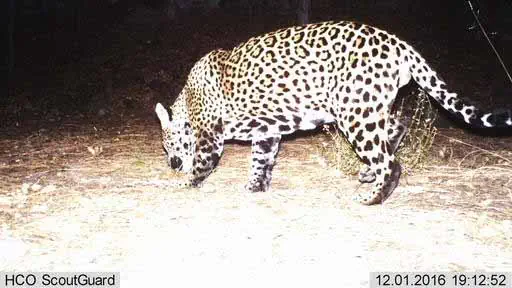
Astrid Galvan | Associated Press
PHOENIX (AP) — A second wild jaguar may have been spotted in the United States.
A photo taken Dec. 1 in a southern Arizona mountain range appears to show a new wild jaguar — an animal rarely seen in the country after its habitat was lost.
The Arizona Game and Fish Department says a preliminary analysis suggests the cat is new to the area and not “El Jefe,” a jaguar that was captured on video in a nearby mountain range last year.
Until now, El Jefe was believed to be the only jaguar in the U.S., although he hasn’t been seen in over a year.
The jaguar in question was seen on a camera belonging to Fort Huachuca, the Army installation about 75 miles southeast of Tucson. The military shared the photo with wildlife officials including Game and Fish and the U.S. Fish and Wildlife Service.
Mark Hart, a spokesman for the Arizona Game and Fish Department, said jaguars migrate from Mexico to southern Arizona about every five to 10 years but that a female jaguar hasn’t been spotted in the U.S. since the 1940s.
“So the quality of life isn’t here for the jaguar,” Hart said.
But Arizona, New Mexico and other parts of the Southwest were home to jaguars before habitat loss and predator control programs aimed at protecting livestock eliminated them over the last 150 years. A hunter shot and killed the last verified female jaguar in the U.S. in 1963 in northern Arizona.
“It’s so exciting that in the last 30 years or so, five or six males have shown up in the U.S. and are starting to re-establish themselves in the historical range,” said Rob Peters, a biologist with Defenders of Wildlife who is based in Tucson. Peters says that although there haven’t been any female jaguars here, the fact that males are establishing habitats is a good sign that they could come in the future.
It could be days before experts determine whether the jaguar seen in a Dec. 1 photo is new.
Hart says analysts will study the jaguar’s rosettes, or the spots within the spots on the cat’s fur, to figure out if it’s been seen before.
Peters says his organization is anxiously awaiting a report by the federal government that is expected to outline a jaguar recovery plan for the area.
“They were once found in Arizona as far north as the Grand Canyon. There were females and cubs in the Southwest,” Peters said.
But protecting the big cats has been fraught with legal challenges.
In March 2014, the U.S. Fish and Wildlife Service set aside nearly 1,200 square miles along the U.S.-Mexico border as habitat essential for the conservation of the jaguar. The New Mexico Farm and Livestock Bureau, New Mexico Cattle Growers’ Association and New Mexico Federal Lands Council filed a lawsuit nearly a year later, saying the decision was “unlawful, arbitrary and capricious” action by federal authorities. That lawsuit is ongoing.
Only El Jefe has made numerous appearances in the U.S. in several years. He first popped up in the Whetstone Mountains in 2011 when he was about 3 years old and showed up again in video in the Santa Rita Mountains south of Tucson around September 2015.
Copyright 2016 The Associated Press. All rights reserved. This material may not be published, broadcast, rewritten or redistributed.
